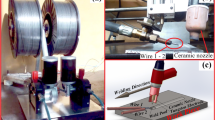Abstract
Automated Gas Tungsten Arc Welding (GTAW) with filler wire addition using a wire feeder is a candidate process for welding of 316LN austenitic stainless steel, which is the major structural material for the Indian 500 MWe Fast Breeder Reactors. In GTAW, the quality of the weld is characterized by the weld-bead geometry as it influences the mechanical properties and its performance during service. This paper discusses the development of computational model using genetic algorithm for determining the optimum/near-optimum GTAW process parameters for obtaining the target weld-bead profile during automatic welding of 316LN stainless steel. Using the experimental data generated on the influence of process variables on weld-bead geometry, regression models correlating the weld-bead shape parameters with the process parameters were developed for determining the objective function in genetic algorithm. Close agreement was achieved between the target weld-bead profile and the model-computed weld-bead profile. This study has shown that use of genetic algorithm is an appropriate methodology for optimising process parameters to obtain target weld-bead profile in GTAW with wire feeder of 316LN stainless steel.
Similar content being viewed by others
References
Mannan S L, Chetal S C, Baldev Raj and Bhoje S B, Trans. Ind. Inst. Metals, 56 (2003) 155.
Yang L J, Bibby M J and Chandel R, Linear regression equations for modelling the submerged arc welds, Journal of Materials Processing Technology, 39 (1993) 33.
Vitek J M, Neural network applied to Welding: Two Examples, ISIJ International, 39(10) (1999) 1088.
Ridings G E, Thompson R C and Thewlis G, Prediction of multiwire submerged arc weld bead shape using neural network modeling, Science and Technology of Welding and Joining, 7(5) (2002) 265.
Dawn White and Jerald Jones, Process modelling with neural networks for pulsed GMAW braze welds, JOM, 49(9) (1997) 49
Kim I S, Son J S, Park C E, Kim I J and Kim H H, An investigation into an intelligent system for predicting bead geometry in GMA welding process, Journal of Materials Processing Technology, 159(1) (2005) 113.
Nagesh D S and Datta G L, Prediction of weld bead geometry and penetration in shielded metal-arc welding using artificial neural network, Journal of Materials Processing Technology, 123(2) (2002) 303.
Cook G E, Barnett R J, Andersen K and Strauss A M, Weld modelling and control using artificial neural networks, IEEE Transactions on Industry Applications, 31(8) (1995) 1484.
Billy Chan, Jack Pacey and Malcolm Bibby., Modelling gas metal arc weld geometry using artificial neural network technology, Canadian Metallurgical Quality, 38(1) (1999) 43.
Correia D S, Gonclaves C V, Junior S C and Ferraresi V A, Comparison between genetic algorithms and response surface methodology in GMAW optimization, Journal of Materials Processing Technology, 160 (2005) 70.
Kim D and Rhee S, Welding Journal, (2001) 80 184s.
Gallagher K and Sambridge M, Computers and Geosciences, 20 (1994) 1229.
Deb K, Sadhana, 24 (1999) 293.
Correia D S, Goncalves C V, Junior Sebastiao S C and Ferraresi V A, J. Brazing Soc. Mech. Sci. Engng., 26 (2004) 28.
Mishra S and Debroy T, A heat transfer and fluid flow model to obtain a specific weld geometry through multiple paths, Journal of applied physics, 98 (2005) 044902 (1)–044902(10).
Kumar A and DebRoy T, Tailoring complex weld geometry through reliable heat transfer and fluid flow calculations and a genetic algorithm, Metallurgical and Materials Transactions A, 36(10) (2005) 2725.
Goldberg David E, Genetic Algorithms in Searc optimisation and machine learning, Addison-Wesley, (1989).
Chakraborti N, Genetic algorithms in materials design and processing, International Material Reviews, 49(3–4) (2004) 246.
Author information
Authors and Affiliations
Corresponding author
Rights and permissions
About this article
Cite this article
Vasudevan, M., Kuppuswamy, M.V. & Bhaduri, A.K. Optimising process parameters for gas tungsten arc welding of an austenitic stainless steel using genetic algorithm. Trans Indian Inst Met 63, 1–10 (2010). https://doi.org/10.1007/s12666-010-0001-5
Received:
Revised:
Accepted:
Published:
Issue Date:
DOI: https://doi.org/10.1007/s12666-010-0001-5




